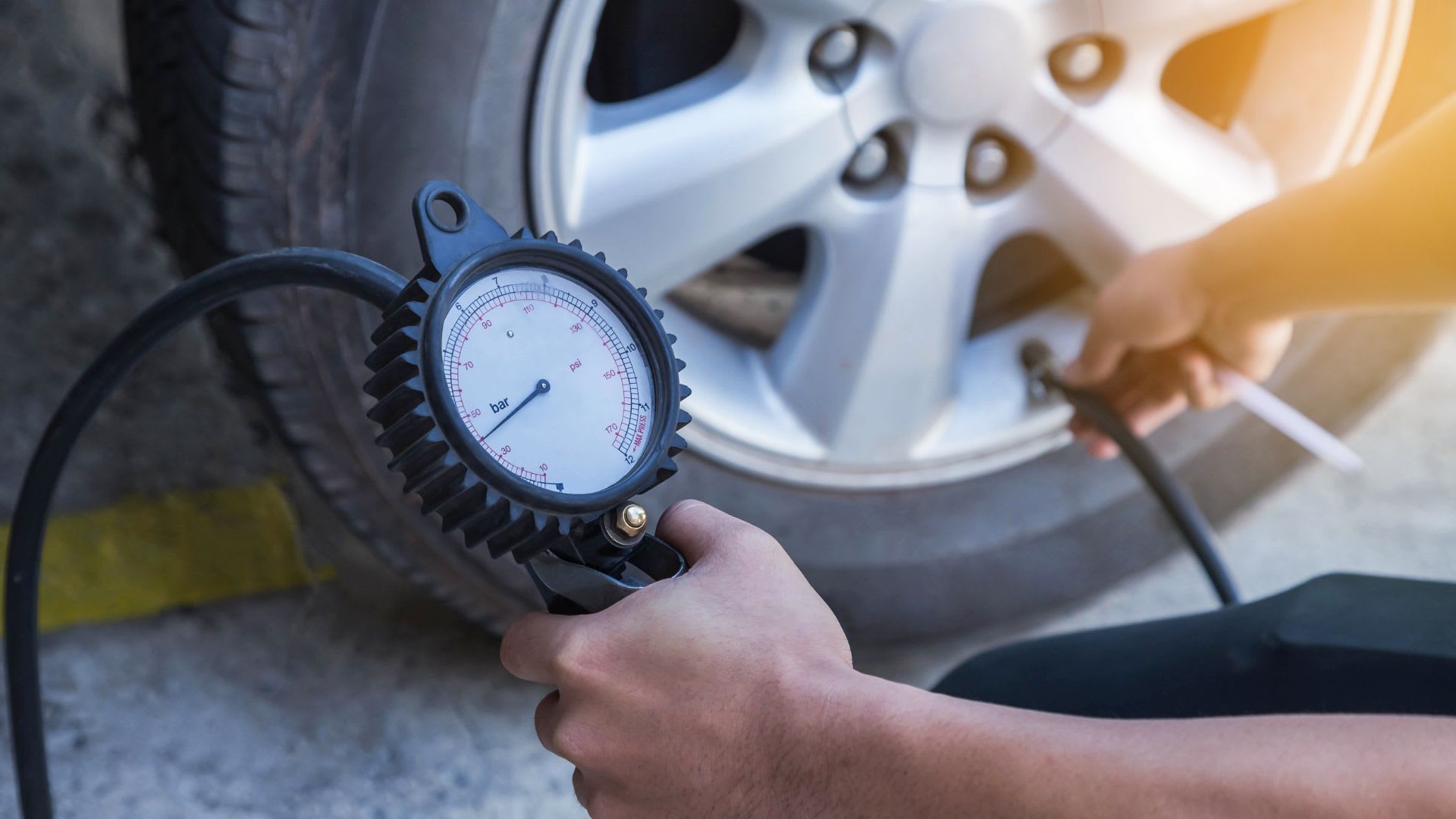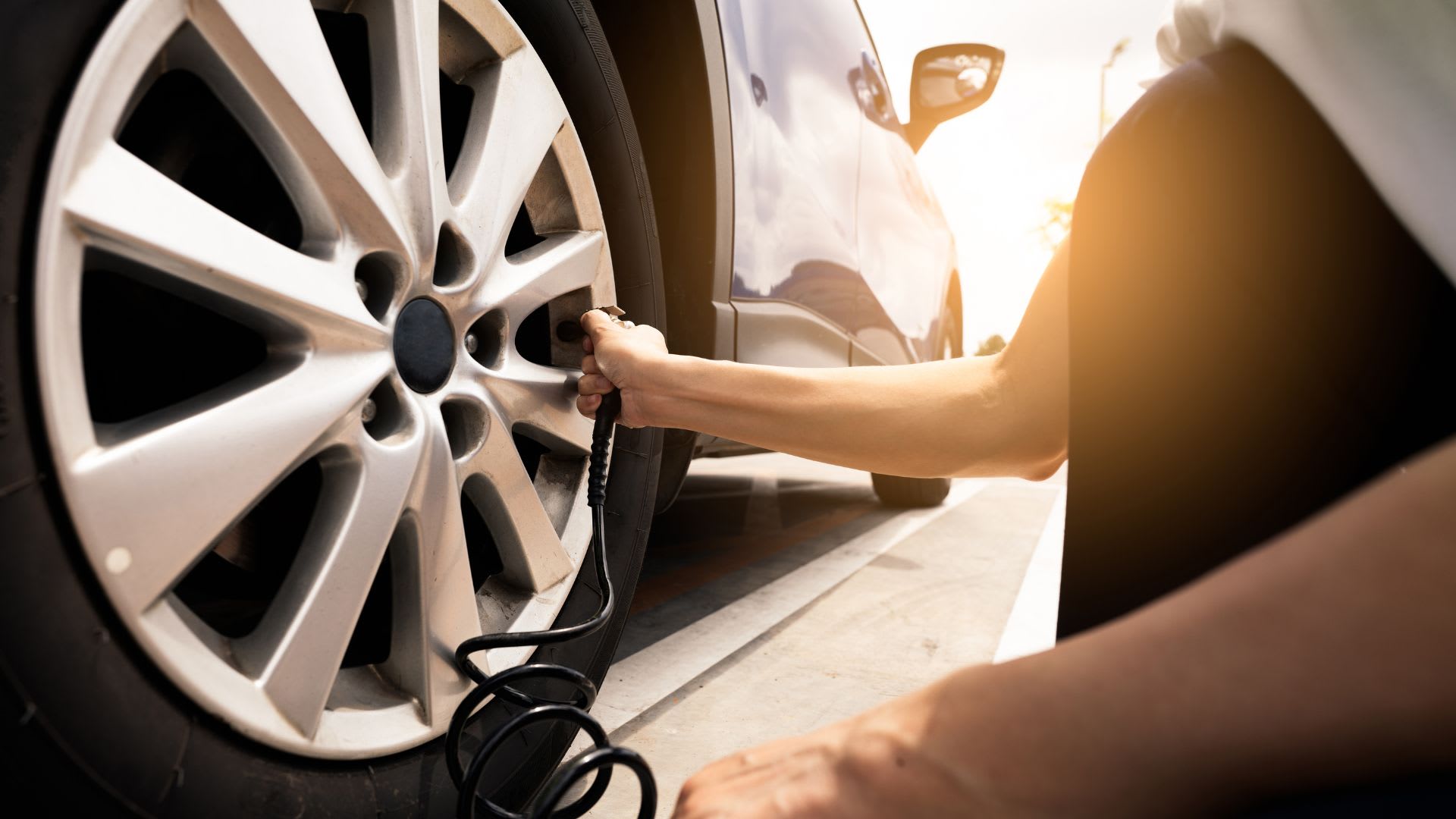Tire Maintenance & Safety
Free shipping
Best price guarantee
Special pricing
Financing with Resolve
Easy returns

Tire pressure affects every aspect of your vehicle's performance: from fuel economy to handling, from tire wear to safety. Understanding the science behind how air behaves inside your tires helps you make informed decisions about maintenance and adjustments.
The mathematical principles that govern tire pressure follow predictable patterns based on temperature, volume, and atmospheric conditions. These calculations matter because proper tire inflation directly impacts your driving experience and your wallet through fuel savings and extended tire life.
Most drivers check their tire pressure without considering the complex physics at work inside those rubber chambers. The relationship between air molecules, temperature changes, and pressure variations creates a dynamic system that responds to everything from weather shifts to altitude changes.
What Does "Taking Air Out of the Tire Equation" Mean?
The phrase "taking air out of the tire equation" has evolved beyond its literal meaning of deflating tires. In the automotive world, it represents two distinct concepts: the mathematical calculations involved in tire pressure management and the emerging technology of airless tires that literally removes air from the design equation. Both interpretations offer valuable insights into modern tire technology and maintenance practices.
Understanding the Mathematical Relationship Between Tire Pressure, Volume, and Temperature
Tire pressure calculations rely on the ideal gas law—a fundamental principle stating that pressure, volume, and temperature maintain a predictable relationship. Inside your tire, billions of air molecules bounce against the rubber walls, creating pressure. This pressure changes based on three key factors:
- Temperature fluctuations: Air expands when heated and contracts when cooled, directly affecting tire pressure
- Volume constraints: The tire's physical dimensions limit how much the air can expand or compress
- External atmospheric pressure: Sea level pressure differs from mountain elevations, influencing gauge readings
The mathematical relationship follows the formula PV = nRT, where pressure multiplied by volume equals the number of gas molecules times the gas constant times temperature. This equation explains why your tire pressure warning light might illuminate on a cold morning even though you recently inflated your tires to the proper specification.
How Air Behaves Inside Your Tires According to Scientific Principles
Air molecules inside a tire behave like tiny baseballs constantly bouncing off the inner walls. The speed of these molecular collisions determines the pressure reading on your gauge. Several scientific principles govern this behavior:
Temperature directly controls molecular speed—hotter molecules move faster and hit the tire walls harder, increasing pressure. A tire inflated to 35 psi at 68°F might read 32 psi when the temperature drops to 32°F. This three-pound difference occurs because cooler air molecules move slower and exert less force against the tire walls.
The compressibility factor of air remains remarkably consistent at typical tire pressures. Even at 60 psi, air deviates from ideal gas behavior by less than one percent, making standard calculations highly accurate for everyday use. This consistency allows for reliable pressure predictions across various conditions.
Why This Matters for Everyday Driving and Tire Maintenance
Understanding tire pressure mathematics transforms routine maintenance from guesswork into precision. Drivers who grasp these principles can anticipate pressure changes and maintain optimal inflation year-round. Proper pressure management delivers multiple benefits:
- Fuel efficiency: Correctly inflated tires reduce rolling resistance, improving gas mileage by up to 3%
- Tire longevity: Proper pressure prevents uneven wear patterns that shorten tire life
- Safety enhancement: Optimal pressure ensures maximum contact patch for superior braking and handling
- Ride comfort: Correct inflation balances cushioning with responsive handling
Seasonal temperature swings create the most noticeable pressure variations. A tire properly inflated in summer might lose 5-6 psi by winter, falling below safe operating levels. Conversely, tires filled on a cold morning could become overinflated by afternoon, especially after highway driving generates additional heat. Regular pressure checks—ideally monthly—account for these natural fluctuations and maintain optimal performance throughout changing conditions.
How Does Tire Pressure Calculation Work?

The Ideal Gas Law
The core principle behind tire pressure calculations links to a well-established formula: PV = nRT. This equation describes how air behaves in a confined space like a tire. Here, P represents the force exerted by air molecules, V signifies the space these molecules fill, n denotes the quantity of molecules, R is a consistent gas constant, and T stands for temperature. The relationship between these elements allows for precise calculations of air volume within a tire, critical for maintaining optimal performance.
In this context, pressure results from the air molecules pushing against the inner walls of the tire, while volume measures the capacity available for the air. With the gas constant and molecular quantity being fairly stable, temperature becomes the key variable affecting tire pressure. As temperatures fluctuate, molecular activities adjust, directly impacting the pressure reading. This formula's application ensures accurate tire air volume calculations across varying conditions.
Temperature and Pressure Relationship
Temperature significantly impacts tire pressure, following a straightforward guideline: for every 10°F change in temperature, expect about a 1 psi shift in pressure. As the air heats, it expands, raising the pressure inside the tire. Conversely, as temperatures drop, the air contracts, leading to reduced pressure. This understanding is crucial for anticipating changes in tire behavior with varying weather conditions.
Imagine a scenario where a vehicle sits outside overnight during a temperature drop. The air inside contracts, potentially setting off low-pressure alerts. Once temperatures rise with the sun, the pressure often returns to its optimal range. Drivers, especially in areas with drastic temperature swings, must routinely check tire pressures to adapt to these natural variations and uphold safety and efficiency.
Real-life examples underscore this effect vividly. A car parked in direct sunlight might show increased pressure by afternoon, while a sudden cold snap could cause pressure to dip below safe levels. Grasping this relationship equips drivers to predict and adjust for pressure changes, ensuring reliable performance regardless of external conditions.
What Factors Affect Air Volume in Your Tires?
Tire volume reflects more than just the air inside; it involves the entire structural design. Various factors shape how much air a tire can accommodate, influencing its performance and safety. Grasping these elements aids in choosing the right tires for your vehicle and maintaining them efficiently.
Tire Size and Dimensions
The physical size and design of a tire dictate its air capacity. Larger tires naturally hold a greater volume of air, affecting traction and ground contact. This becomes crucial for vehicles that navigate rugged terrains or carry substantial loads, where larger tires can enhance stability and control.
Rim width significantly affects internal volume. A wider rim permits a broader tire profile, increasing the space available inside. This change can impact the tire's load-handling capacity and its road contact capabilities. Selecting an appropriate rim width is vital for optimizing tire function and durability.
Sidewall Flexibility and Load Rating
Sidewall flexibility influences how a tire absorbs shocks and retains pressure. More pliable sidewalls may offer a smoother ride but can lead to pressure variations. In contrast, stiffer sidewalls typically improve handling and stability, especially during high-speed travel or when bearing heavy loads.
Load rating, indicated on the tire's sidewall, is directly tied to air volume requirements. Tires with higher load ratings are designed to support more weight, requiring a larger air volume to maintain their shape and performance under stress. Understanding your vehicle's load specifications and aligning them with the tire's load rating ensures safety and efficiency.
Considerations for Optimal Performance
Achieving the correct air volume involves more than inflating tires to a suggested level. Drivers should consider how varying load conditions, road surfaces, and driving habits affect tire performance. For example, heavier loads might necessitate additional air to manage increased pressure on the tire structure.
Routine checks of tire dimensions, rim compatibility, and load ratings ensure that tires operate within their optimal parameters. This practice not only prolongs tire life but also boosts fuel economy and safety. By evaluating these factors, drivers can make informed decisions about tire maintenance and selection, ensuring a balanced and efficient driving experience.
Understanding the Math Behind Letting Air Out of Tires
Calculating Air Release
Releasing air from a tire involves precise calculations to ensure safe and efficient pressure adjustments. Begin by determining the current tire pressure and the desired target pressure. This differential guides how much air needs to be released. It's essential to consider factors like altitude, as changes in elevation can affect air pressure within the tire due to variations in atmospheric pressure.
The time required for deflation depends on the valve's size and the rate at which air can flow. Larger valves facilitate quicker air release, which can be beneficial for rapid adjustments but requires careful attention to prevent excessive deflation. Smaller valves provide more controlled deflation, allowing for precise adjustments to reach the desired pressure. Understanding this balance ensures that deflation is both accurate and appropriate for the driving conditions.
Practical Pressure Adjustments
To adjust tire pressure accurately, follow a systematic approach. Begin by measuring the current pressure with a precise gauge. Release air incrementally, checking frequently to ensure you do not exceed the desired pressure drop. This careful process helps maintain the tire's performance and longevity.
For effective adjustments, essential tools include a high-quality tire pressure gauge and possibly an air compressor for reinflation. A valve core removal tool can also expedite the process of releasing air in larger quantities when necessary. These tools, used properly, simplify the adjustment process and enhance accuracy.
Avoid common mistakes by considering environmental factors like altitude, which can affect tire pressure. Drivers often overlook the impact of external conditions, leading to inconsistent tire performance. By following a structured routine and using the right tools, drivers can ensure their tires are properly adjusted for optimal safety and efficiency.
Effects of Tire Pressure on Vehicle Performance

Fuel Economy and Efficiency
The relationship between tire pressure and fuel efficiency is a key factor in vehicle operation. Tires that are not inflated to the recommended levels create more friction with the road surface, causing the engine to expend additional energy. This increased energy use leads to greater fuel consumption. By ensuring tires remain at optimal pressure, drivers can reduce unnecessary fuel usage, contributing to both cost savings and environmental benefits over time.
Handling and Braking
The influence of tire pressure on a vehicle's handling and braking performance is critical. Insufficiently inflated tires result in a compromised contact area, which can lead to decreased steering precision and an increased risk of losing control during maneuvers. Conversely, excessive inflation can reduce the tire's ability to grip the road properly, adversely affecting stopping distances. Achieving the right tire pressure is essential for maintaining control and ensuring the vehicle responds accurately to driver inputs, particularly in challenging driving conditions.
Tire Wear and Safety
Pressure levels within tires directly affect how they wear over time, with incorrect inflation leading to premature and uneven tread degradation. Tires that wear unevenly not only reduce the lifespan of the tires themselves but also pose a safety hazard. By maintaining the recommended pressure, drivers can ensure that their tires wear evenly, extending their usability and enhancing overall vehicle safety. Regular checks and adjustments help prevent the risks associated with improper inflation, such as blowouts or loss of control, thereby safeguarding both the vehicle and its occupants.
Advanced Concepts: Beyond Traditional Air-Filled Tires
Alternative Inflation Methods
Exploring alternative methods for tire inflation has introduced innovative solutions beyond conventional air-filled tires. One of these advancements is the use of nitrogen to fill tires instead of standard air. Nitrogen offers benefits such as reduced pressure loss over time due to its larger molecules, which seep out of the tire more slowly than oxygen molecules. This feature can enhance tire longevity and decrease the need for frequent pressure checks.
When considering different gases, nitrogen stands out for its inert properties, which help minimize oxidation within the tire. This reduction in oxidative reactions can lead to an extended lifespan for the tire's internal components. While the upfront cost of nitrogen inflation may be higher than using air, the long-term advantages include consistent pressure retention and decreased maintenance requirements.
The concept of airless tires represents a radical departure from traditional designs by eliminating the need for inflation entirely. These tires incorporate engineered structures, like intricate webs, that provide support without the risk of punctures or flats. By removing air from the tire equation, airless tires offer enhanced durability and require less maintenance, making them an attractive option for those seeking reliability and low upkeep.
Temperature Compensation
Temperature variations significantly influence tire pressure, necessitating adjustments to maintain optimal performance. In colder weather, air contracts, which results in a drop in tire pressure. It's essential for drivers to account for this contraction by ensuring tires are properly inflated during the winter months to maintain safety and performance levels.
Seasonal pressure changes can be anticipated by understanding the relationship between temperature and air volume within tires. As temperatures fall, the air inside contracts, reducing pressure; conversely, warmer temperatures cause expansion, which can lead to overinflation if not carefully monitored. Implementing a routine of seasonal checks and adjustments helps ensure tires remain within their optimal pressure range throughout the year.
For effective year-round tire maintenance, regular pressure monitoring and adjustments are crucial, especially in response to temperature fluctuations. Employing precise gauges for accurate readings and considering external factors like altitude and humidity can further optimize tire performance. By adhering to these practices, drivers can maintain proper inflation across varying conditions, thus enhancing safety and efficiency on the road.
Practical Applications: Your Tire Inflation Guide
To manage tire pressure effectively, utilizing a quick reference chart for common tire sizes and pressures is essential. These charts provide guidelines based on tire specifications and vehicle requirements, ensuring that you maintain the correct pressure for optimal performance. By keeping a printed or digital version of such a chart readily available, you can easily verify and adjust your tire pressure as needed.
Developing a personalized tire pressure calculation spreadsheet enhances precision and convenience. By entering specifics such as tire dimensions, current pressure, and temperature, this tool calculates necessary adjustments tailored to your vehicle's conditions. This customization takes into account factors like driving habits and seasonal changes, ensuring that tire pressure remains optimal.
Leveraging technology through mobile apps designed for tire air volume tracking further optimizes tire maintenance. These apps offer features such as real-time monitoring and pressure alerts, allowing for proactive management. They often integrate with tire pressure monitoring systems (TPMS) to provide continuous updates and historical data analysis, ensuring that your tires are always correctly inflated.
Knowing the optimal times to check and adjust tire pressure is crucial for maintaining vehicle performance. Regular monthly checks are advised, with adjustments during seasonal shifts or after carrying heavy loads. Aligning these checks with routine vehicle maintenance helps maintain consistent tire pressure, thereby improving fuel efficiency and extending tire life. Regular monitoring and adjustment ensure smooth and safe vehicle operation.
Understanding the science behind tire pressure empowers you to make smarter maintenance decisions that save money and improve safety. Whether you're calculating pressure changes, adjusting for temperature variations, or exploring new tire technologies, the knowledge you've gained helps optimize your vehicle's performance. When it's time to replace your tires, we make it easy to shop for tires online and find the best deals that match your driving needs and budget.
Ready to find the perfect tires?
Search By